Cryptocurrency Statistics, Facts By Growth, Ownership, Adoption, Country, Trends and Recent Developments (2025)
Updated · Nov 24, 2025

Table of Contents
- Introduction
- Editor’s Choice
- Total Cryptocurrency Value
- Crypto Ownership Rates
- Cryptocurrency Owners Worldwide
- Cryptocurrency Rapid Growth
- Cryptocurrency Adoption Rates Worldwide
- Cryptocurrency As A Payment Method By Country
- Impact of Economic Conditions On Crypto Adoption
- Top Cryptocurrencies
- Rapid Expansion In Developing Economies
- Slower Adoption And Regional Declines
- Recent Developments
- Conclusion
Introduction
Cryptocurrency Statistics: No longer a field secluded in the confines of tech companies and the early elite investors, the field of cryptocurrency is becoming a truly vibrant and fluid world of finance, very much breaking through into mainstream life, cross-border trading, and digital innovation. Originally conceived as futuristic and cryptic, money-saving, financing, and cross-border activities are some concrete things that people do with crypto today.
The digital currency landscape has never been more dynamic and exciting, with newer stunts in terms of technologies, platforms, and use cases emerging every day. In this article, we will discuss the key and trending Cryptocurrency statistics.
Editor’s Choice
- In the year 2024, US$40.9 billion in cryptocurrency was sent to illegal addresses, with the end-of-year estimates likely to surpass US$51 billion.
- A total of 28% of adults in the United States now hold cryptocurrency, from just 15% back in 2021.
- 67% of all the crypto owners in the United States are males, with the median age being 45, and they usually hold at least two cryptocurrencies.
- Global crypto adoption rose to 12.4% in 2025, spearheaded by the Asia-Pacific region, Latin America (15.2%), and Africa (19.4%).
- Stablecoins have moved into the first position for transaction volume at 33.2%, while institutional investors are next in line with 16.5%.
- Increase in adoption for payment: with 82% of merchants in El Salvador, and more than 31,000 retailers in Japan are accepting crypto.
- Economic uncertainty drives adoption: Argentina, 29.4% ownership, Venezuela, 16.3%, Turkey +31.5% trading volume, Egypt +42.8% activity.
- US$1 trillion 30-day volume dominates exchanges by Binance, followed by Coinbase Pro (US$523B) and Coinbase (US$350B).
Total Cryptocurrency Value
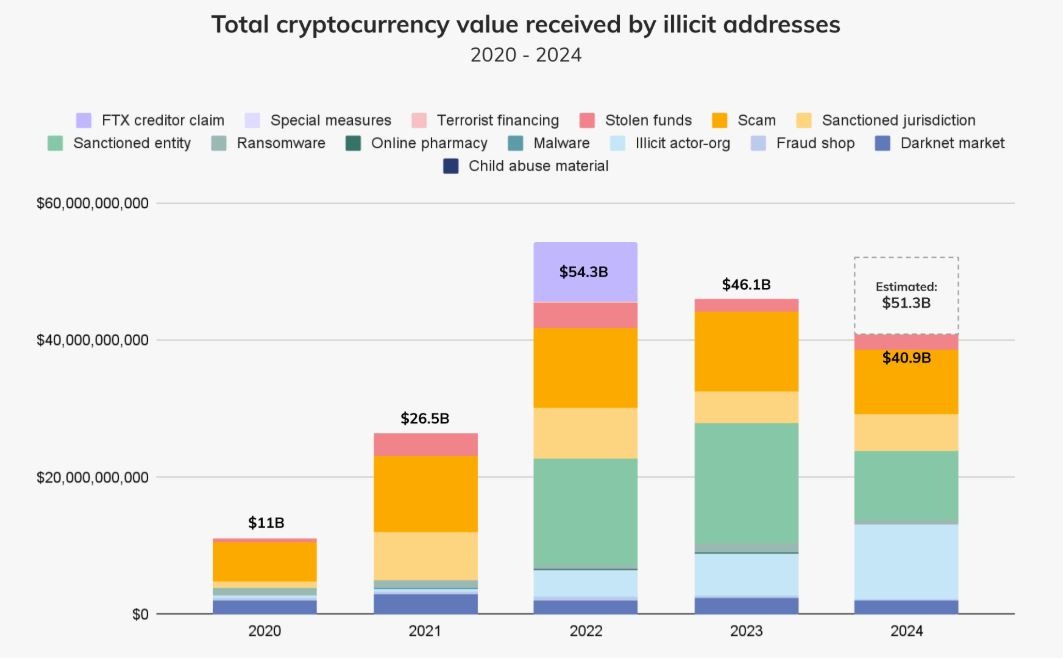
(Source: chainalysis.com)
- As per Chain Analysis, Cryptocurrency statistics show that the data reveal that around US$40.9 billion was sent to illicit addresses in 2024.
- However, this number is not final; rather, it is an underestimation, as the analysts have only tracked addresses identified so far.
- The total linked to criminal activity will only go up as more illegal wallet addresses are uncovered in the future.
- For instance, during the initial release of last year’s report, the estimated total for 2023 was US$24.2 billion.
- However, a year after additional illicit addresses were uncovered, they had to increase the number to US$46.1 billion, almost doubling it.
- Most of these new additions are related to organized illicit groups, including vendors linked to Huione platforms that provide on-chain services to help criminals move and launder money.
- From this example, it is justifiable to agree that the actual figure for 2024 will eventually be higher than that of 2023.
- In recent years, the total valuation of illicit crypto activity has increased by 25% per annum after revisions of data.
- Given the continuation of this trend, the final estimate of 2024 should exceed US$51 billion when all concealed activities are accounted for at the end.
Crypto Ownership Rates
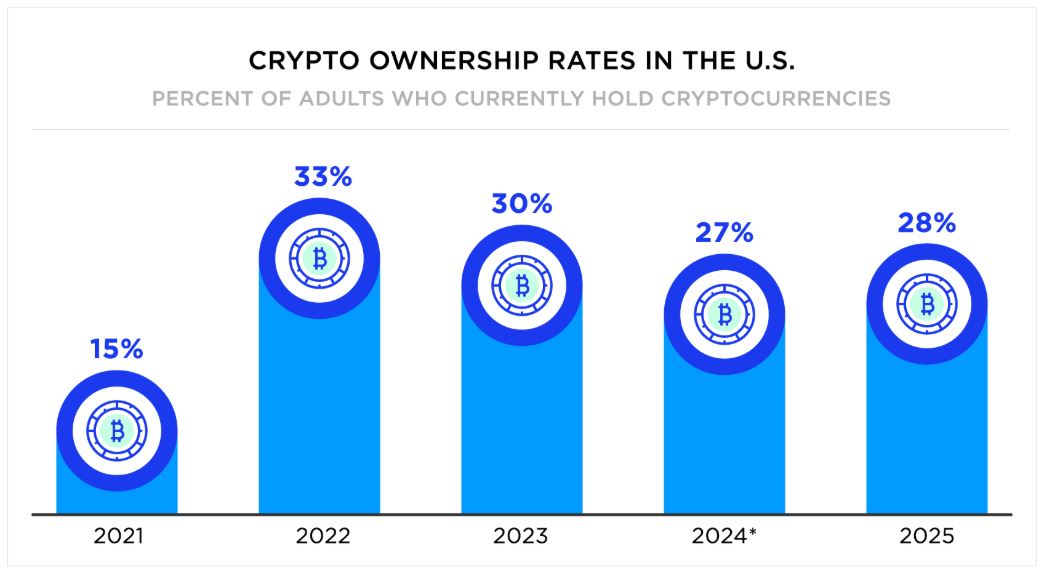
(Source: security.org)
- Today, in worldview and industries such as technology and finance, more and more people understand crypto as a sort of open financial system: it is on the internet and does not have a private company or bank running it.
- It became clearer and evident for the masses since Bitcoin’s inception in 2009. Studies show that roughly around 28% of U.S. adults—really about 65.7 million people—have some sort of cryptocurrency at present, which is 13% more than the 15% held in 2021.
- This essentially means that trust was rekindled in 2022, which was called the “crypto winter,” perhaps due to the downturn.
- Men constitute the majority of crypto owners—the figure is around 67%, thereby leaving 33% for women.
- It is more common among the younger Generation X and older Millennials, with 45 as the median age of a crypto owner.
- Most individuals do not stick to just one type of coin. The average holder owns at least two different cryptocurrencies.
- About 14% of non-owners intend to purchase some in 2025, with nearly half of the non-owners (48%) open to doing so.
Cryptocurrency Owners Worldwide
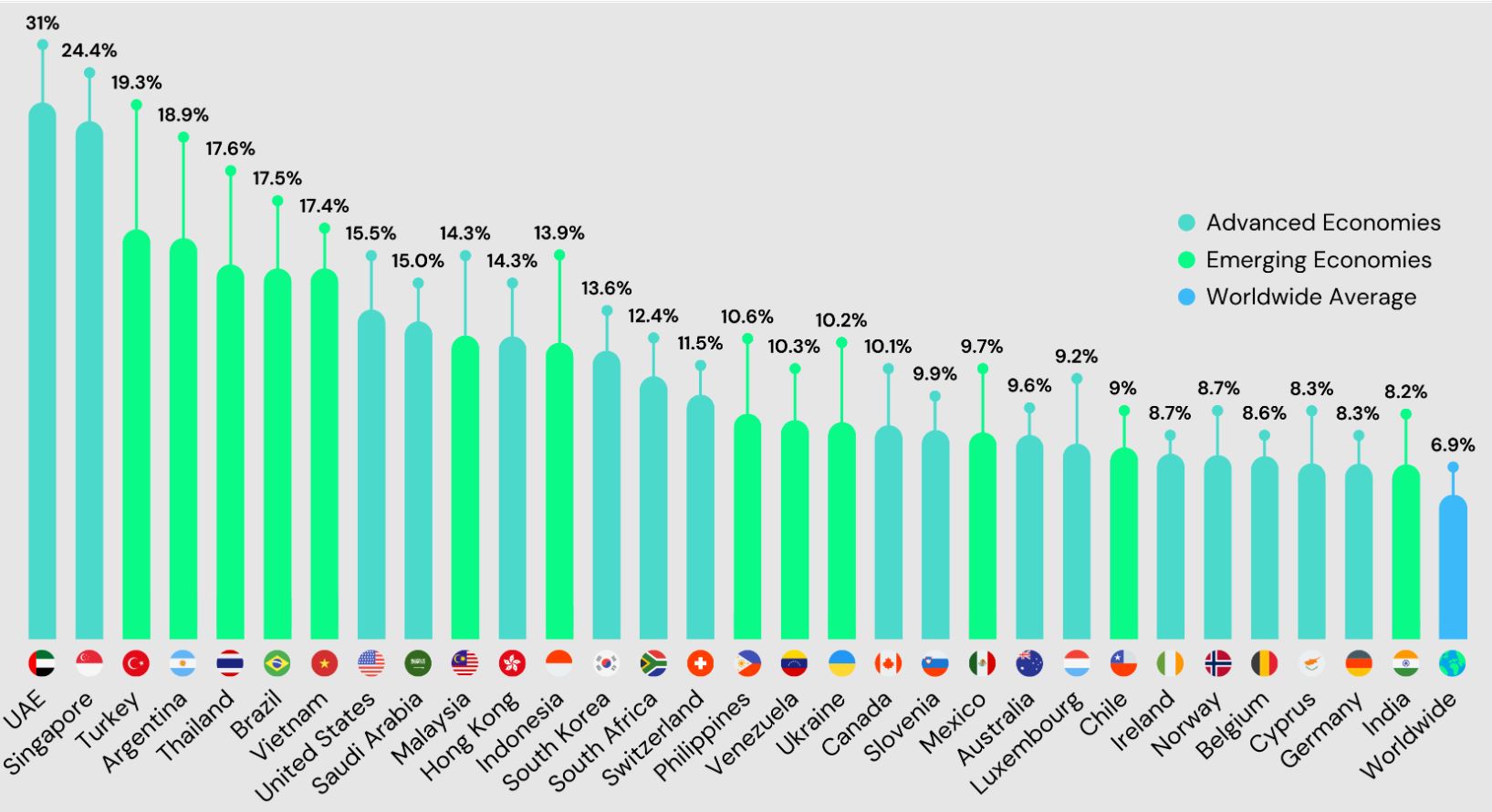
(Source: triple-a.io)
- The data shows how widely cryptocurrency ownership has become across different countries, according to the figures for 2023.
- India is the world leader in terms of the number of owners, with about 93.5 million people owning crypto out of its 1.42 billion population, implying that roughly 6.55% of Indians have some form of cryptocurrency.
- Close behind China is an estimated 59.1 million crypto owners, equal to 4.15% of the population of 1.42 billion.
- The U.S. boasts a smaller population but a high ownership rate — close to 15.56% of Americans, or 52.9 million, hold cryptocurrency.
- Vietnam is considered to have one of the highest adoption rates in the world.
- More than 20.9 million Vietnamese, about 21.19% of the population, own crypto, indicating strong grassroots participation despite lesser numbers than larger countries.
- Pakistan sees about 15.9 million crypto holders, making up 6.6% of the population; the Philippines stands tall with 13.43%, counting over 15.7 million owners.
- Brazil, too, is marked by strong adoption, having nearly 26 million holders of crypto or 11.99% of its population.
- Nigeria has a steady 13.3 million, or 5.93%, skewing toward the use of digital assets for remittances and savings.
- Iran hosts close to 12 million crypto users, 13.46% of its population, with high engagement despite economic sanctions and financial restrictions.
- Indonesia, with its vast population of over 277 million, claims about 12.2 million owners, meaning nearly 4.4% of Indonesians have either invested in or use crypto.
Cryptocurrency Rapid Growth
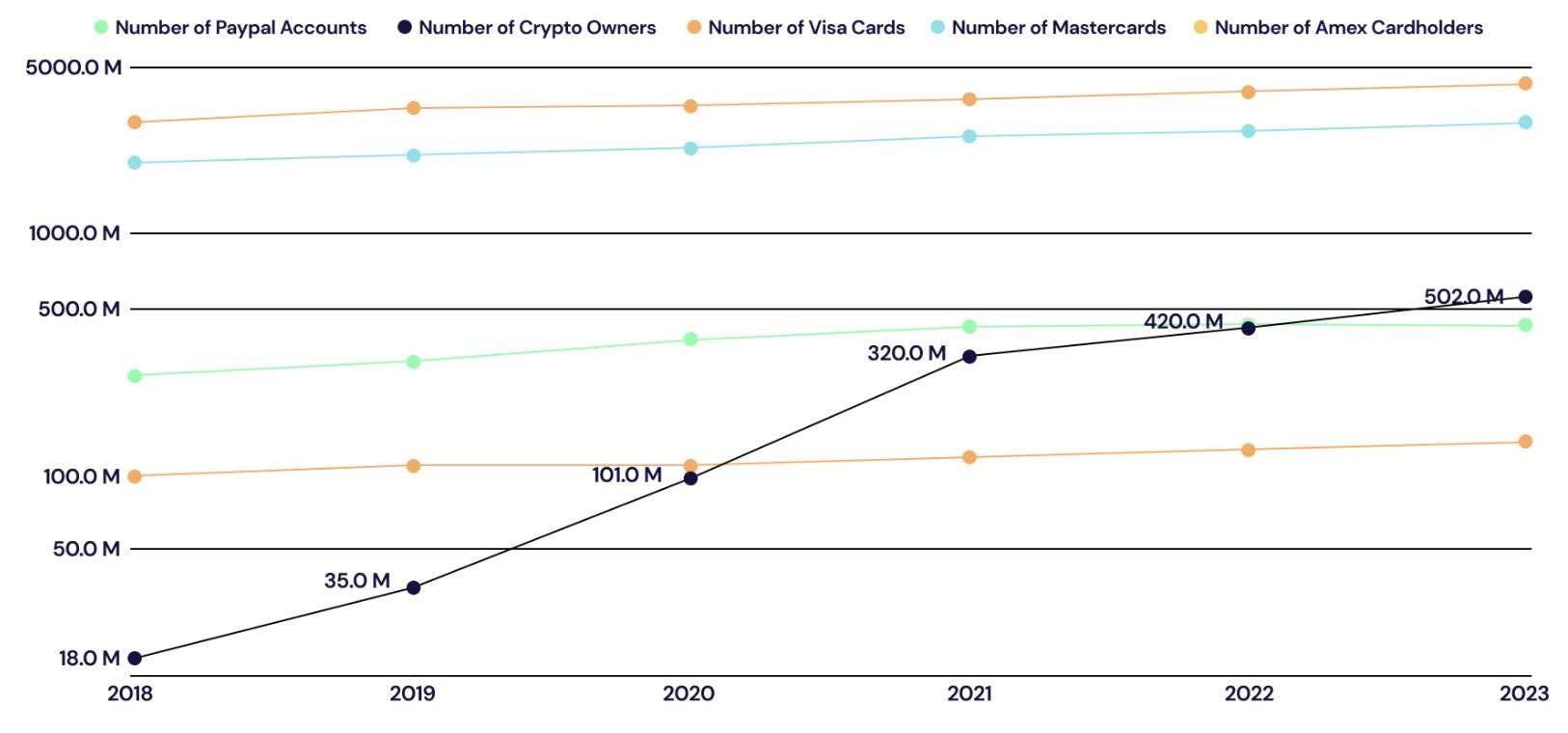
(Source: triple-a.io)
- There has been a rapid increase in ownership in this new-age asset, especially very recently.
- The rates between 2018 and 2023 were an astronomical 99% CAGR rate, meaning that every year, nearly twice as the people owned crypto.
- These growth rates are by far greater than those witnessed by conventional modes of payment, which grew at an annual rate of 8% approximately for the same period.
- This is to say that while crypto adoption rates surged faster and beyond those of, say, credit card usage or conventional tools like American Express, those slowly gained users over time.
- It shows how quickly the world has turned to digital assets, not just as speculative vehicles but as new forms of payment and financial access.
Cryptocurrency Adoption Rates Worldwide
- The steady growth of cryptocurrency adoption continued across the globe in 2025, with 12.4% of the world’s population holding some form of digital asset.
- The Asia-Pacific region remains at the forefront of the trend, as six out of ten countries with the highest adoption rates are located there.
- In Europe, clearer government regulations and greater involvement from traditional financial institutions helped lift the adoption rate to 8.9%.
- Latin America experienced one of the sharpest rises to an average national adoption rate of 15.2%, mainly driven by people using crypto as a hedge against inflation and unstable local currencies.
- For the year, the African continent constituted the fastest relative growth, with the number of crypto users rising by 19.4%.
- Countries such as Nigeria, Kenya, and South Africa spearheaded this growth, underscoring crypto’s role in financial inclusion, where traditional banking facilities lack such.
- Middle East growth stayed strong, with 11.3% of adults from the region holding on to digital assets.
- Institutional investors 2025 had rapidly grown to account for 16.5% of all global crypto transaction volumes.
- Stablecoins, digital currencies pegged to traditional assets like the U.S. dollar, made up 33.2% of total transaction volume, further indicating the shift of investors to stable and utility-oriented tokens instead of the highly volatile ones.
- Intermediate in terms of their practical effect on international finance, blockchain solutions accounted for about 9.6% of total worldwide remittance flows, enabling faster and cheaper cross-border payments.
- Additionally, 5.4% of global B2B trade settlements were done through cryptocurrencies, signalling that too, cryptocurrencies are slowly entering global trade and finance as a functional avenue.
Cryptocurrency As A Payment Method By Country
- By 2025, the use of cryptocurrencies for payment will have extended into many nations with different levels of acceptance.
- El Salvador continues to top the charts, with about 82% of surveyed retailers accepting Bitcoin as payment, a clear recognition by the entire nation of the currency.
- In Japan, as many as 31,000 retailers accept crypto, including major convenience stores and leading technology outlets, placing it among the top retail markets for crypto in Asia.
- Germany is making some progress through the acceptance of crypto payments for online shopping via more than 26 fintech partnerships in the country, accounting for almost 9.3% of all e-commerce checkouts.
- The Philippines, on the other hand, boasts over 1.1 million merchants linked to crypto payment processors such as Coins.ph and GCash, contributing to the quick incorporation of digital wallets for everyday transactions.
- In the United States, Adoption is far more fragmented, yet it stands quite high at 17.4% of small and medium-sized businesses accepting cryptocurrency, with stablecoins such as USDC favoured for their price stability.
- There is first-worthy infrastructure growth in Brazil, wherein the number of crypto-enabled POS terminals witnessed a 22.7% increase in 2025, crossing the 92,000 mark on installations throughout the country.
- South Africa is witnessing a bloom in peer-to-peer transactions, while 15.6% of mobile payments are performed using stablecoins, demonstrating tremendous grassroots adoption.
- Luxury retailers and hotels lead the way in the United Arab Emirates, where about 43% of five-star hotels accept crypto pay directly, marking the acceptance of crypto in high-end markets.
- In Ukraine, more than 800 tech startups have introduced payroll systems based on crypto, especially for the efficient payment of international freelancers.
- Meanwhile, Thailand continues to impose limits on the use of crypto for physical goods, while it is freely allowed for travel and digital services, supported by officially licensed payment channels.
Impact of Economic Conditions On Crypto Adoption
- Economic instability around the world was one such event leading to crypto adoption.
- Buy into digital assets much more often in countries with inflation above 20%, on average, 2.7 times compared to an economically stable country.
- A clear example of that is Argentina, where, after having inflation at 85% in 2025, approximately 29.4% of Argentines held crypto to safeguard their savings.
- Somewhere around 16.3% of Venezuelan households use crypto, mainly USDT and Bitcoin, to cover their daily expenses due to the diminishing value of the local currency.
- The weakening of the Lira and its continuing downside in Turkey actually brings about a 31.5% increase in crypto trading volume on a year-on-year basis.
- Further, in Egypt, a 42.8% increase in crypto activities is recorded in 2025, owing mainly to the higher level of devaluation of the currency and restrictions on funds being moved abroad.
- Zimbabwe has a dynamic informal crypto-economy, with unofficial estimates of digital transaction volumes touching 6.2% of the country’s GDP, standing tall with the highest per capita figures in the world.
- In the US, at the time of the mild recession that happened at the start of 2025, there was a surge in crypto ownership, with about 15.2 million new wallet activations by investors seeking an alternative.
- Banking crises in Lebanon have led to around 19.8% of citizens using crypto wallets as the main way to safely store value outside traditional banks.
- The Pakistani market has done considerably well, and crypto remittance is now soaring at 18.7%, mostly through Binance P2P, as people want to avoid losses from the rupee’s instability.
- In Ukraine, cryptocurrency is literally continuing support to humanity, with US$2.1 billion estimated in crypto-aided assistance and DAOs furthering finance for defence efforts and local relief projects.
Top Cryptocurrencies
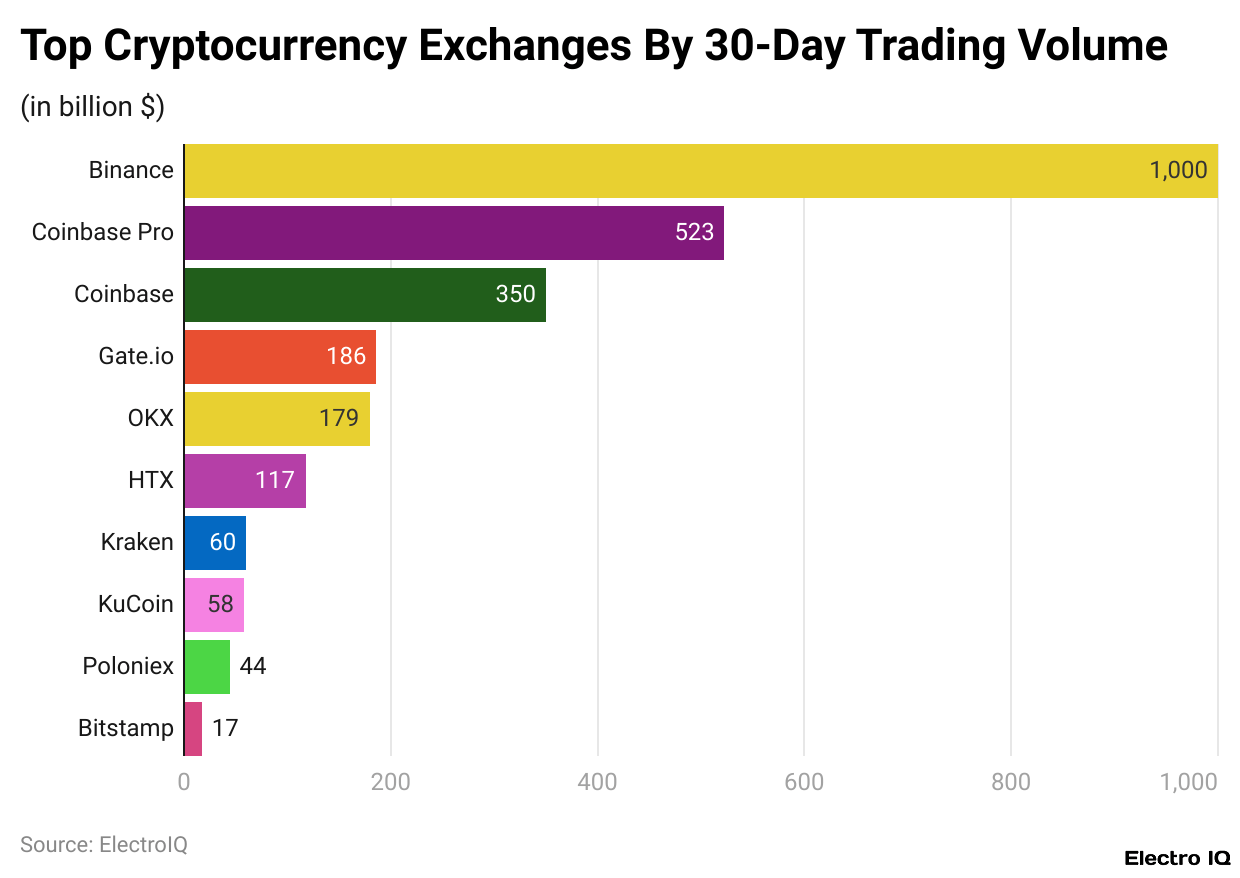
(Source: chainalysis.com)
- In the past 30 days, Binance continued to dominate the world cryptocurrency exchange market with astronomical trading volumes of US$1 trillion, more than any other competitor.
- Coming in second is Coinbase Pro, having observed average levels of activity amounting to a trading volume of roughly US$523 billion.
- This strong showing represents the heavy engagement of U.S. institutional investors who use this platform for large trades.
- The regular Coinbase exchange stands at number three and caters mainly to retail users with a trading volume of US$350 billion.
- Gate.io holds the fourth rank based on having traded US$186 billion in a month.
- Next up is OKX, another Asia-based exchange with US$179 billion, strongly underscoring the continued strength of the Asian market in the worldwide crypto trade.
- With US$117 billion in trading activity, HTX (formerly Huobi) maintains a very strong presence in the market.
- Banking US$60 billion, Kraken leads among the U.S.-based exchanges, while KuCoin, with US$58 billion, trails very closely behind, showing continued solid activity from the worldwide user base.
- And still, Poloniex treats US$44 billion worth of trades, and Bitstamp, a long-grizzled veteran of the European crypto space, closes the list of the top ten trading volumes with US$17 billion.
Rapid Expansion In Developing Economies
- Cryptocurrency came into widespread use across several emerging economies throughout 2025.
- Philippine ownership climbed 22.5% in 2025, up from 17.8% in 2024, with play-to-earn gaming and remittances standing central to the use of digital assets.
- Pakistan made an addition of 5.4 million users to hit 18.2 million crypto holders, with freelancers and workers abroad carrying cross-border income and payments via cryptocurrencies.
- A remarkable 40.6% increase in Peru was sustained by the steady acceptance of stablecoin payments across retail outlets.
- DeFi activities were up 6.8 times since 2023 in Tanzania, with the number of wallets growing from 120,000 to 820,000. 3.1 million verified users of crypto now exist in Bangladesh, mostly owing to the popularity of stablecoins as a cheaper means of remittance.
- In Ghana, crypto ownership maintained an increase of 38.2% in 2025, fueled by education programs for students and young professionals.
- After the introduction of crypto mining-friendly regulations in Uzbekistan, wallet growth was recorded at 19.5% to touch 4.6 million.
- Once after licensing seven crypto projects under its central bank regulatory sandbox, Morocco’s registration for adoption shot up another 5.4%.
- Kazakhstan’s heavy investment in mining infrastructure paid off as it together with 23.1% growth in wallet use to 6.7 million users.
- Meanwhile, Cambodia imbued a hybrid process by integrating cryptocurrency into its Bakong national digital wallet system, now featuring 740,000 hybrid wallet users combining both fiat and crypto functionalities.
Slower Adoption And Regional Declines
- Some countries are rushing into growth and expansion of crypto activity, while others firsthand view of this expansion slowing or dying off.
- China continued to be suppressed by its regulatory restrictions, unto an ownership rate falling to around 5.2% in 2025.
- India’s high crypto taxes discouraged retail traders; wallet growth recorded a mere 3.8% year-over-year increase.
- The UK saw a 2.6% decline in active users due to stricter KYC rules and the delisting of certain coins from local exchanges.
- Germany’s new regulations on staking services caused a drop in DeFi wallet activity by 7.3%.
- There occurred a drop of 14.2% in trading volume in France, which was occasioned partly by the collapse of local exchanges that heavily impacted investor confidence.
- The hardening of South African capital gains tax laws saw new wallet registrations slow down to a mere 2.1% increase, while declining crypto ETF markets in Canada have seen institutional trading flows drop by 5.4%.
- Meanwhile, Japan saw a 3.2% decline in retail trading despite maintaining a stable legal framework, since it still had little innovation in local platforms.
- Finland and Norway have experienced less than 1.5% wallet growth, much of which is due to users holding the older cryptocurrencies as opposed to those in either DeFi or NFT trends.
- Malaysia is stuck at 2.8 million active users, thus signalling a momentary standstill in interest.
Recent Developments
- In 2025, stablecoins, by far, have accounted for over 50.1% of the world’s crypto transaction volume, emphasising their role in payments.
- The IMF issued guidance that encouraged countries to clear crypto regulations, while El Salvador raised US$753 million by floating a second Bitcoin-backed bond.
- Visa and Mastercard allowed direct crypto payments across 43 countries, with USDC and EURe topping in usage.
- Binance resumed operations in Canada, while BlackRock threw weight behind three tokenized ETFs.
- Well, the Cancun upgrade on Ethereum has cut gas fees by 37.9%, thus gearing up NFT and gaming activities.
- Ripple, Robinhood, PayPal, and Circle went global with services, thereby creating millions of new wallet users.
Conclusion
Cryptocurrency Statistics: The rise of cryptocurrencies has moved the industry from a niche curiosity purely based on digital principles into a worldwide financial phenomenon shaping the way people invest, transact, and access financial services. Technology and economics drive its adoption across continents. Various use cases present stablecoins and institutional participation as the next frontier, beyond the speculative realm of remittances with blockchain.
With soaring adoption in emerging markets, all the while confronting regulatory challenges and economic instability affecting its regional growth pattern, cryptocurrency earns its stripes as a revolutionary force in everyday trade and international finance through exchanges, wallets, and payment systems.
Sources
FAQ.
Criminals sent around US$40.9 billion in cryptocurrency to illicit addresses in 2024. As more wallets are yet to be identified, analysts expect this number to reach US$51 billion, marking a trend that shows a steady increase in criminal activity linked to cryptocurrencies.
Almost 28% or maybe 65.7 million U.S. adults possess cryptocurrency, a big surge from just 15% in 2021. Ownership is far more prevalent among men, Generation X, and older Millennials.
Vietnam tops the list with an adoption rate of 21.19%, followed by the United States at 15.56%, and then the Philippines at 13.43%. Asia-Pacific, Latin America, and Africa are the fastest-growing regions, fueled on both sides by investment interest and economic instability.
Cryptocurrency payment acceptance is rising wherever one looks. El Salvador tops the list with 82% merchant adoption, Japan has over 31,000 retailers accepting crypto, and the U.S. reports that about 17.4% of its small and mid-sized businesses are big users of digital assets, mainly stablecoins like USDC.
Binance leads the charge with US$1 trillion for 30-day trading volume, followed by Coinbase Pro (US$523B); Coinbase (US$350B). Also, colossuses are thrown in the pot of Gate.io, OKX, HTX, Kraken, and KuCoin, reflecting deep global participation from both retail and institutional investors.

I hold an MBA in Finance and Marketing, bringing a unique blend of business acumen and creative communication skills. With experience as a content in crafting statistical and research-backed content across multiple domains, including education, technology, product reviews, and company website analytics, I specialize in producing engaging, informative, and SEO-optimized content tailored to diverse audiences. My work bridges technical accuracy with compelling storytelling, helping brands educate, inform, and connect with their target markets.










